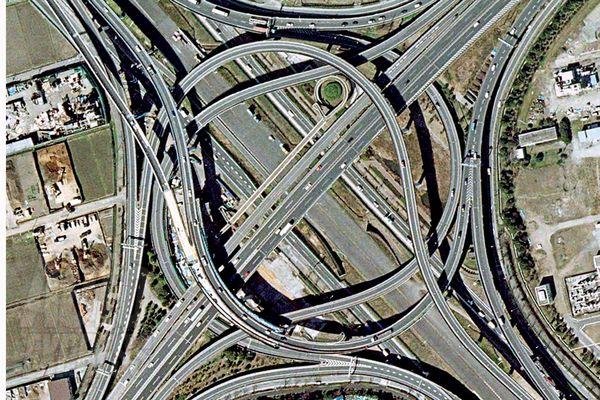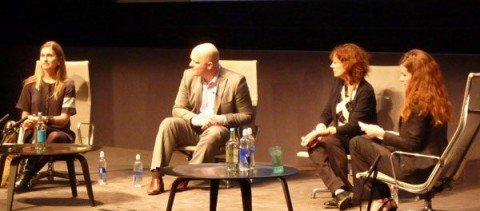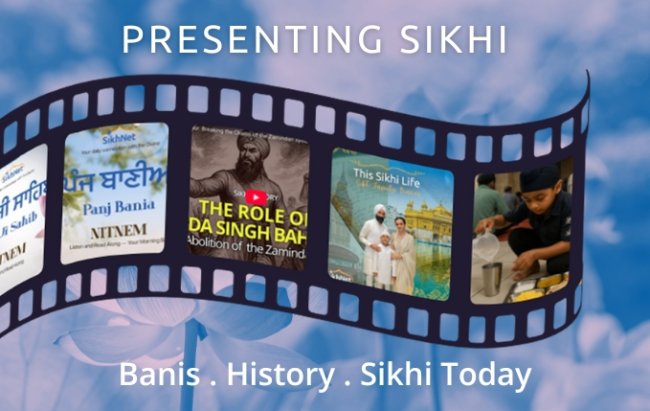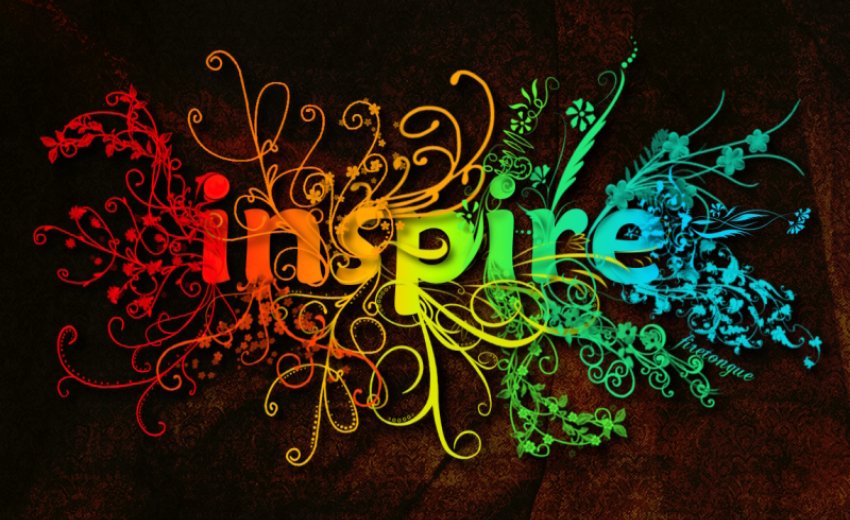
A movie star, a yogi and an Iraq War veteran walk into a bar...
Ok, not a bar. But no joke, this unlikely group got together last weekend, along with about a dozen other movers and shakers, at Pixar Animation Studios for some very serious business.
It's called Intersection, a gathering of original thinkers who spent a full day sequestered together to brainstorm big ideas and then share them. Their focus is not entertainment or profit or policy. It's social change.
Intersection founder Randy Haykin believes that putting a wildly diverse group of very driven people in a room together just might be the key to launching the new innovations that will change the world.
"The greatest number of creative ideas come at the intersection of a variety of team members, cultures, or perspectives," said Haykin, a veteran venture investor who has turned his passion for innovation toward solving pressing social problems as cofounder of social innovation incubator The Gratitude Network.
Haykin conceived of Intersection as a kind of highly concentrated, speeded-up version of what's known as "cross-sector collaboration." His inspiration for the name came from Frans Johansson, author of The Medici Effect: Breakthrough Insights at the Intersection of Ideas, Concepts and Cultures.
Johansson, who will be a speaker and brainstormer at the event, defines an intersection as the point where "ideas collide and combine with concepts from diverse industries, cultures, departments, and disciplines to ignite an explosion of creativity and groundbreaking innovation."
If he's right, the explosion could be colossal with this group. Aside from the movie star (Susan Sarandon), the yogi (Guru Singh), and the veteran (Paul Reickhoff), there will be entrepreneurs and leaders from fields that Haykin says are poised to have the greatest impact on social change: non-profit, corporate innovation, and education. They'll spend the day before the conference sharing their boldest ideas for addressing major global challenges and crafting solutions.
Corporate innovators include IDEO CEO Tim Brown, Walt Disney CTO Greg Brandeau, Google VP Marissa Mayer, and Pixar Animation Studios president Dr. Ed Catmull. The individuals chosen to be part of this group have the particular qualities that make innovators unique, said Haykin.
"An innovator is someone who takes things that already exist in the world and repositions them or recombines them in a new and unique way, and then is able to take that recombination and create something practical out if it that the world can use," he said. "They have a single-minded dedication to some universal principal."
Johansson added, "Innovators have an almost irrational belief and an irrationally strong feeling or passion about something, and it can't necessarily be deduced through logic that it's a good idea."
It's exactly this kind of unreasonably inventive idea that the brainstorming group will present the following day -- the official day of the conference -- to 350 attendees (also from these potent fields, and including students). The audience will then split up into breakout sessions led by the speakers to contribute their ideas, widening the scope of co-collaboration and the breadth of perspective.
This kind of inspired collaboration and fast tracking of innovation is right up Benjamin Wald's alley. As executive partner of Ashoka Changemakers, he has been spearheading the creation of a new online platform to make intersections happen constantly, on a global scale. He, along with Ashoka's president Diana Wells, will be part of the core brainstorming group and a speaker at Intersection, where he will introduce the platform and its governing philosophy of Open Growth.
"Open Growth is founded on the principles of transparency and radical openness, and it creates an environment that supports the spawning and evolution of innovative ideas," Wald said. "It's a framework where people can transparently track their growth to solicit the resources they need -- from startup capital to talent."
The platform will be like an online marketplace to get concrete support for social innovations so that they succeed and stick. The attendees at the event may decide to bring their own ideas for solutions onto the platform to find more surprising partners and resources, and to grow them into global models for change.
It's just one possible outcome of Intersection; with the unlikely mix of participants, there are too many to even imagine. And yet of course, it's the unimaginable that Haykin is hoping will emerge from what he expects will be the first of an enduring annual event.
Already Haykin has plans to make sure the momentum from the two-day event propels tangible results. The attendees will become a pool of mentors for social innovators identified by The Gratitude Network as promising investment-worthy enterprises.
And profits from this and future Intersection conferences will be used to seed innovations that come out of, or are inspired by, the brainstorming sessions. Attendees will be kept apprised of the innovations' growth and have opportunities to continue contributing expertise and resources to make them thrive.
So, a movie star, a yogi and a vet walk into a bar. What happens? They change the world. No joke.
##########
Notes from the Intersection of Inspiration and Disappointment
Shira Kates
Source
 |
| A panel discussion with Susan Sarandon and friends |
The venue, Pixar studios in Emeryville, California was an impressive backdrop to an event where “the most respected innovators in the world converge with leading social change agents to tackle some of the greatest issues of our time.”
The Intersection began with oomph. The first speaker, Frans Johansson, was smart and dynamic. After giving a TED-quality talk, he led a panel discussion with Tim Brown and Dr. Ed Catmull. Both men offered engaging and thought-provoking insights into the creative process at IDEO and Pixar. The following breakout sessions were well-received, at least in their potential as networking opportunities. Later, I heard that many were disappointed that the energy and ideas produced in the breakout sessions were not carried forward in a later session.
Many of the early panelists and discussions seemed to connect with the audience. But around lunchtime the energy shifted. Grumblings overheard while hungrily waiting in the lunch line, revealed a growing dissatisfaction around planning and logistics. A premier viewing of a Pixar short was well-loved by those who were in the theater at the right time. But the audience viewings were staggered and several of my colleagues did not arrive until the end of their viewing, due to lack of communication in the lunch hall.
A promising panel discussion with Susan Sarandon, Paul Rieckhoff and Lauren Bush turned into an unfortunate disaster. The audience appeared to be in anguish as the hair-flipping facilitator attempted to form a pithy sentence, laboriously sharing her own assessments of pretty much everything and anything, ad nauseum, rather than working to draw the best from the speakers and help them promote their respective causes.
Ms. Sarandon, et al, were forced to exercise tremendous patience and humility (which they did, and I applaud their grace). Thank God for Guru Singh who saved the day at least twice. Once by raising our spiritual consciousness and our voices in song, and once by gently hijacking the Bush/Sarandon/Reikhoff panel in order to move on with the show.
Several attendees left after the men’s a capella chorus, Voices in Harmony, performed a tribute to the late Steve Jobs. Later, the nearly all-Caucasian chorus performed the Toto hit, Africa with hand-woven tribal cumberbunds draped jauntily over their shoulders. Their enthusiasm almost made up for the unfortunate musical choices. The majority of remaining attendees exited after the Ashoka launch announcement. The final segments were hurried due to other sessions going overtime. The lesser-known speakers were saved for last; perhaps not the best strategy for an all-day Saturday event.
Concluding announcements resolved with an invitation for the “young innovators” to go upstairs for a special session. Strangely, the young innovators did not include all of the student attendees. Just the ones under 25 (which was communicated in an offhand “I just thought of this and made up a number” sort of way), which meant that about half of my fellow classmates were allowed to attend while I, an MBA student at the not-so-tender age of 36(!), technically was not allowed. Umm. Awkward! This special session which I spied from below with myopic, soon-to-be-middle-aged eyes, appeared to be completely unstructured; just a chance to network a little bit more. But it’s hard to say for sure. It’s possible I’m just a cranky old lady.
As a student paying $199 to attend this event, I was mostly satisfied with the value/price ratio, but can imagine those who personally shelled out for full price admission, a whopping $1995, were probably more pained than I by the event’s hiccups. Gratefully, proceeds from the event will be donated to The Gratitude Network, a social entrepreneur investment fund.
We ended on a high note by snapping cheesy photos with the fluffy Monsters Inc. replica and other Pixar characters. And then went for a cocktail to where we innovated new ways to produce world-changing intersections. ‘Cuz that’s what we do and that’s how we roll.

